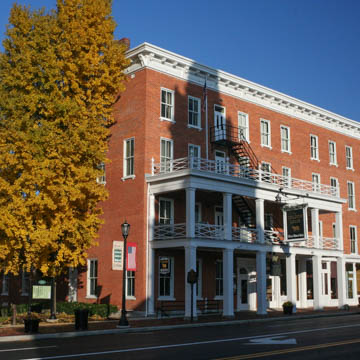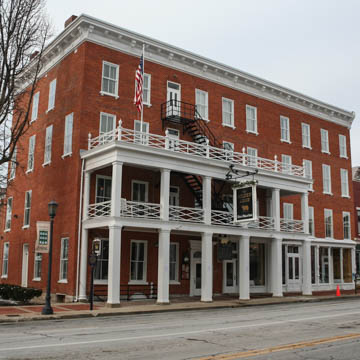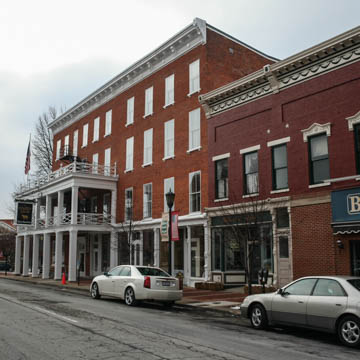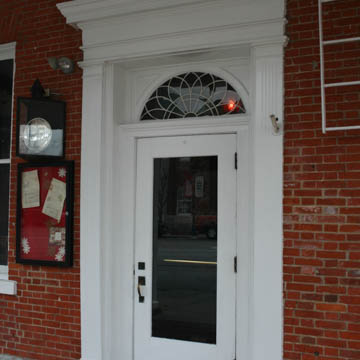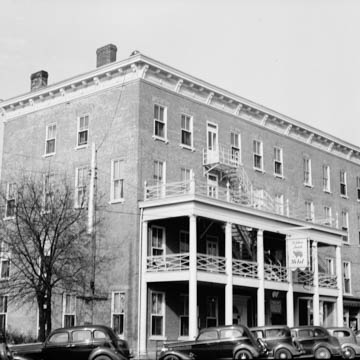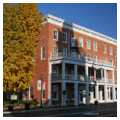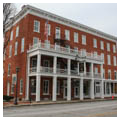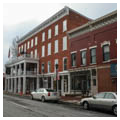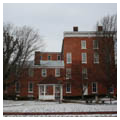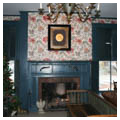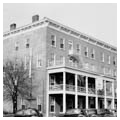The Golden Lamb, Ohio’s oldest continually operating hotel, is located in the center of downtown Lebanon at the intersection of Main Street (SR 63) and Broadway (SR 42), the main route between Cincinnati and Columbus. Set off from the corner by a green space, the building shares the intersection with the county courthouse to the east, and the public library to the south, and is among the most prominent buildings in this county seat town.
The hotel is a four-story, red brick building with semi-regular bays of windows, a bracketed wood cornice, and a prominent two-story, six-bay portico, which reflect a simple Italianate style. The main block is four bays deep, and a two-story wing extends from the rear. The windows of the main block have two-over-two wood sashes and sills with small brackets, while the two-story rear wing has six-over-one wood replacement sashes. The white-painted wood portico, which was added c. 1929, has square columns and a delicate metal railing with a diagonal design. The ground floor has three painted wood storefronts on the right side of the facade.
The Golden Lamb has evolved over two centuries, beginning with a two-story log tavern on the site in 1803. This was replaced in 1815 with the original six-bay, two-story, red brick building facing east on Broadway near Lebanon’s commercial crossroads. In 1826, a perpendicular six-bay, two-story wing was built on the rear at the south end. Twenty years later, a third story was added on the original six-bay building, followed in 1854 by a four-bay, three-story addition on the north side. In 1878, a fourth story was added over the full ten-bay building. While the careful observer can detect the various stages of construction by the slightly irregular pattern of the window bays and seams in the brick masonry, the overall effect is unified because of the simplicity of the design. In 1964, a tavern wing was added on the rear.
The plan of the bottom two floors is roughly U-shaped, while the floors above the two-story rear addition are L-shaped. Predictably, the first floor is divided into a lobby at the southeast corner, which leads to various dining rooms, while the upper floors have double-loaded corridors lined with small hotel rooms. Interior features include angled jambs at the windows and four-paneled doors with box locks.
The Golden Lamb occupies a central location in Lebanon and is a highly visible structure, due to its large size. It was a focal point of early cultural life in Lebanon, hosting public entertainment and civic events and serving as a stagecoach stop on the major transportation corridors of the day. In continuous operation for over two centuries, the Golden Lamb has been associated with many important historical figures, including the twelve U.S. presidents who have stayed there.
In the parlors of the Golden Lamb plans were made by leaders in politics, law, business, and industry for Ohio's canals, improved roads, railroads, and bridges. Political rallies and celebrations were frequent occurrences. When Jeremiah Morrow was elected Governor of Ohio in 1822, a delegation was organized in the hotel to notify him of his election. One of the largest gatherings was at a dinner in honor of DeWitt Clinton in July 1825 to celebrate the beginning of the Miami and Erie Canal. Other guests included the Governor of New York, General (and future president) William Henry Harrison, statesman Henry Clay, Governor Ethan Allen Brown, and Jeremiah Morrow.
Daniel Webster, the great orator, spent the night here in 1833. William Henry Harrison spoke here during his presidential campaign of 1840. Charles Dickens dined here and complained about its being a temperance hotel. Presidents James A. Garfield and William McKinley visited several times while campaigning for office. President Benjamin Harrison was entertained here when he came to address a reunion of soldiers at the Warren County Fairgrounds. More recent presidents to visit the Golden Lamb include Ronald Reagan and George W. Bush.
The transformation of the old hotel into an attraction and notable restaurant began with its acquisition by Robert H. Jones in 1926. Jones and his wife, Virginia Kunkle, whom he married in 1928, returned the hotel to its original name, The Golden Lamb, and undertook an extensive remodeling program. They added the picturesque porch with tall white pillars and furnished the interior with antiques, many of them from local Shakers.
The Historic American Buildings Survey documented the Golden Lamb early on, in 1936. The Daughters of the American Revolution marked it in 1940 as the oldest hotel in Ohio. This ceremony attracted thousands of guests including Governor John Bricker, and former governors Myers Y. Cooper and C. Bascom Slemp, who served as secretary to President Calvin Coolidge. In January 1956, the Turtle Creek Chapter of the Daughters of the American Revolution made their first presentation of an Award of Merit. Recognized for its importance as an early inn and as the setting for many historic events and gatherings, the Golden Lamb is also listed in the National Register of Historic Places. The Golden Lamb is still owned and operated by members of the Jones family and several of the inn’s rooms are open to the public as a museum.
References
Cleveland, Betty A. “The Golden Lamb,” Warren County, Ohio. National Register of Historic Places Inventory-Nomination Form, 1978. National Park Service, U.S. Department of the Interior, Washington, DC.














